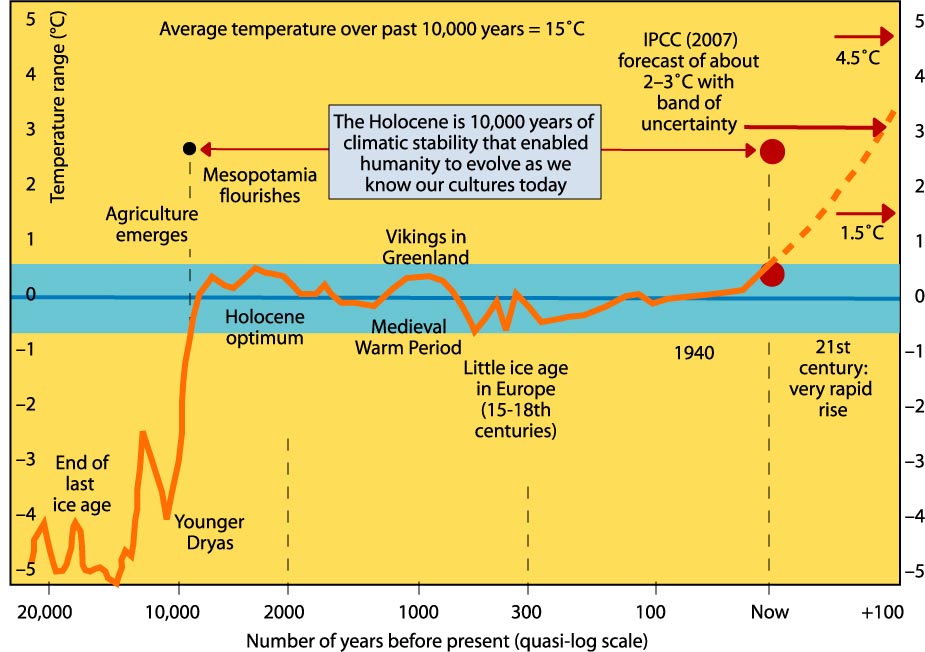In a new scientific paper (pdf, 600kb) prominent climate scientist James Hansen and his colleague Makiko Sato argue that the Earth is now at least as warm as it was between earlier ice ages, and further warming by even one degree celsius could result in sea level rising by anything from 5 to 25 meters, with perhaps 5 meters rise by the end of this century.
This implies more stringent limits than current, politically-adopted targets to keep warming below two degrees celsius and atmospheric carbon dioxide content below 450 parts per million (ppm). Hansen now says the present targets are “prescriptions for disaster”, and that we must keep warming to less than one degree. This requires reducing atmospheric carbon dioxide to less than 350 ppm, from its present value near 390 ppm, as quickly as possible.
Meeting the new targets would require very rapid reductions in emissions of carbon dioxide and other greenhouse gases, and active efforts to withdraw carbon dioxide from the atmosphere. Bio-sequestration (using plants to build carbon in soil) is an option that can be undertaken immediately.
Advertisement
Given that existing policies in most countries fall well short of meeting even the old targets, this adds a new level of urgency to the existing urgency to begin major and effective efforts immediately.
There are three main approaches used to understand global warming: direct measurements of the world at present, computer models, and records of past climate extracted from sedimentary rocks and polar ice cores. The latter, deciphering natural records, has the advantage of looking at natural experiments that include all the complications of the real climate system, whereas computer models do not handle well some difficult factors such as cloud and aerosol variations. It depends, of course, on correctly and accurately deciphering the subtle chemical and isotopic records in the rocks and ice, but scientists have been unravelling those signals for quite a long time and a lot is known. Hansen and Sato have built on earlier work using recent data sets.
Over the past million years or so the climate has swung between ice ages and briefer, warmer “interglacial” periods. For the past 10,000 years, during which civilisation developed, we have been in a warm period called the Holocene in which temperature and sea level have been unusually stable. (Graph courtesy of ClimateCodeRed blog.)

The old targets, limiting the temperature increase to less than 2 degrees celsius and carbon dioxide to less than 450 ppm, were based on ice core records, which indicated that two previous interglacial periods, about 120,000 and 400,000 years ago, were 2.7-3.7 degrees celsius warmer than the Holocene. The figure below shows two estimates of ice-age temperatures (red) compared with the same reference calculation (blue) based on known ice extents and greenhouse gas concentrations. Panel (a) shows ice-core estimates, featuring quite high peaks in several of the more recent interglacials. At those times sea level was 5 metres or more higher than now.

Advertisement
However Hansen and Sato now argue that the ice core record is affected by extra regional warming over the polar ice sheets, and it is not representative of the globe as a whole. They argue the deep sea sediment record is more globally representative, and this shows the earlier temperature peaks to have been no more than 1 degree warmer than now, as can be seen in Panel (b). So in this interpretation, sea level was 5 metres higher despite the temperature being no more than one degree higher than now.
To explain the difference between the ice core and deep ocean records, Hansen and Sato argue that there are several positive feedbacks that come into play at temperatures near the present temperature, and they would accentuate the tendency of polar regions more strongly than the rest of the globe. As temperatures rise through the present level, sea ice melts, ice shelves disappear, so the exposed water absorbs more solar heat than the ice it replaces. Also as surface melting occurs on ice sheets they darken significantly, so they also absorb more solar heat.
At present polar temperatures increase about twice as much as the global average, but the feedbacks would increase this ratio. Thus the ice sheets in the past warm intervals would have experienced the stronger warming recorded in the ice cores. Correspondingly they would have melted more, raising sea level several metres above present levels.
Discuss in our Forums
See what other readers are saying about this article!
Click here to read & post comments.
41 posts so far.